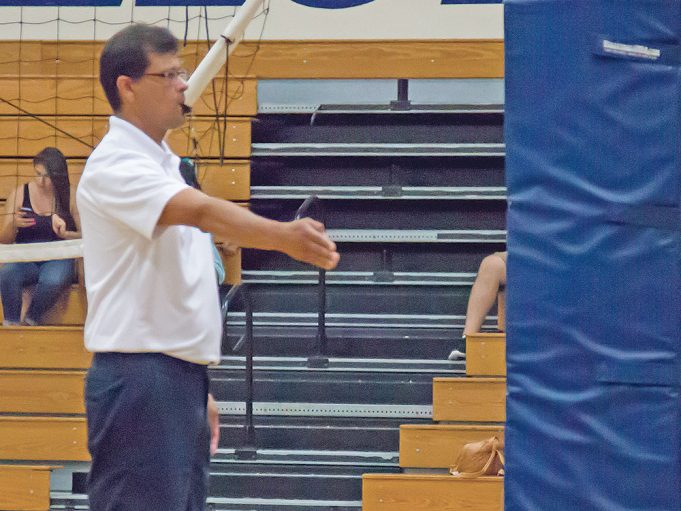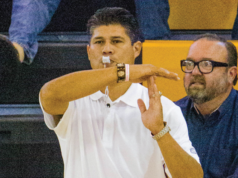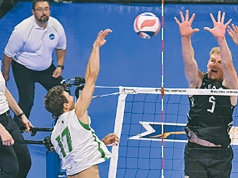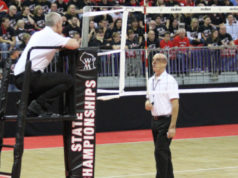Volleyball referees don’t move a lot during play, compared to referees in other sports. But there are a lot of challenges involved in calling — from a relatively stationary position — a fast-paced sport in which 12 players are constantly moving and the ball is deceptively delivered to both teammates and opponents.
The second referee has the opportunity to move more than the first referee and must anticipate plays and be in the best position to make decisions about the legality of players and the ball.
As referees improve their skills in an attempt to move “up the ladder,” it is often second referee skills that are a limiting factor. As the speed and complexity of play increase, the second referee must be skilled at anticipating the play and adjusting his or her position to make the best judgments. The second referee’s work area, compared to officials in other sports, is relatively limited — but transitioning effectively and making minor position adjustments when needed can open up a line of sight that allows a good decision.
The fundamentals of second referee positioning appear to be very straightforward. The second referee begins each rally on the receiving team’s side of the net pole, focused primarily on the receiving players’ positions. After the serve is contacted, the second referee is to transition to the blockers’ side of the net during play, watching for net and center line faults in particular. Those instructions sound relatively easy, but a mechanical movement to those basic positions is only Chapter 1. Transitioning during the play is a bit more complicated when done correctly and effectively.
A strong volleyball IQ is important for the second referee
Before the serve, the second referee’s position is on the receiving team’s side, squared to the court, about three to four feet back from the net post and no more than one to two feet laterally from the center line extension. On contact of the serve, the second referee transitions immediately to the other side of the center line extension, while watching each contact of the ball. That initial transition should start with service contact, so that the second referee is in position with eyes and head still as the play nears the net. While on the blockers’ side, the second referee must still watch the play develop, and has primary responsibility for net faults on all players, which means second referees must develop the habit of looking through the net to see the attacker. Most second referees find it helpful to move the foot nearest the center line back a little, angling the body slightly toward the attacker’s side of the net. It’s important to view the play through the net not only for net faults, but also to observe the take-off point of back-row players and libero plays near the attack line.
As the rally continues, the second referee transitions to the blocking team’s side each time the ball crosses the net. Watch the entire play develop until the play moves toward the net, and then focus on the net and center line until the play has moved away from that area and there are no players at risk of committing a net or center line fault. Then, while transitioning again to the blocker’s side, pick up the flight of the ball. Transitions should be made with a purpose, not by “strolling” into position.
The method used for transitioning is personal preference. Some second referees use a front or back crossover step, others just step laterally to the new position. Any of those methods may be used, as long as the second referee can move smoothly and efficiently, without closing off one side of the court by turning the body too much.
At times, secondary transitions will open up better sight lines to view the play. A minor adjustment from the base position, either slightly to one side, or a step toward or away from the sideline, may be helpful. Those adjustments must be anticipatory, so that the second referee is not moving at “decision time,” and should only be used when needed. For example, an excellent referee might anticipate a potential pancake play on one side, and move an extra small step toward (or away from) the sideline to see the play clearly, so that help can be offered to the first referee if needed.
A strong volleyball IQ is important for a second referee. The best second referees take care of all the duties in their job description, while being “in the head” of the first referee so that appropriate assistance can be provided when needed. It takes a lot of practice to gain those skills, so take advantage of opportunities to work in that role when you can. Being in the right place at the right time is key to making good decisions, so practice transitions, footwork and focus until they are second nature.
What's Your Call? Leave a Comment:
Note: This article is archival in nature. Rules, interpretations, mechanics, philosophies and other information may or may not be correct for the current year.
This article is the copyright of ©Referee Enterprises, Inc., and may not be republished in whole or in part online, in print or in any capacity without expressed written permission from Referee. The article is made available for educational use by individuals.


















